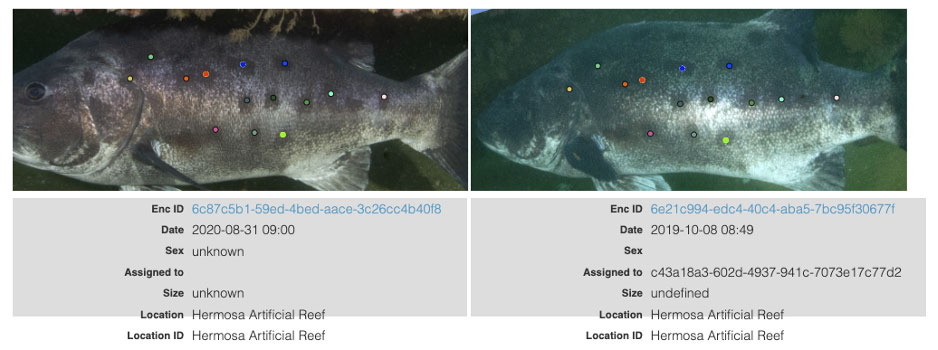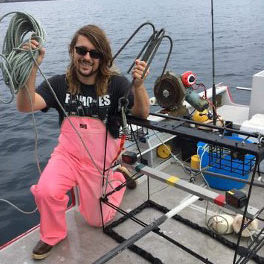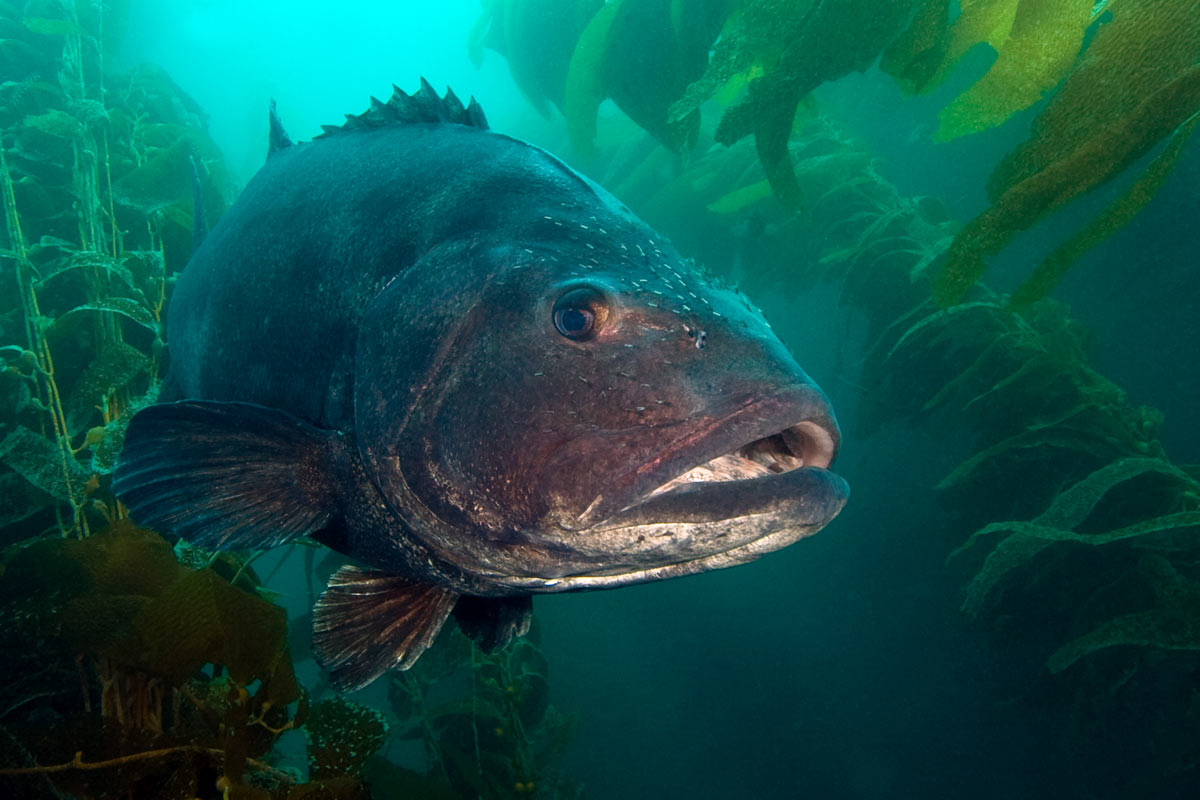It’s truly amazing that you can be cruising around the kelp specifically looking for a giant sea bass, and all of a sudden, you realize that one’s looking right back at you. They’re amazingly well-camouflaged, especially on a sunny day when the light is dappling through the kelp. And as long as you don’t make any quick moves, they seem as interested in us as we are in them. It’s not unusual for them to give you the once-over, move away, and then circle back for another look. You start to wonder: Who’s watching whom?
— Ken Kurtis
The “King of the kelp forest,” otherwise known as the giant sea bass, reigns supreme as the largest nearshore bony fish in California. These majestic giants can reach lengths greater than seven feet and weigh over 550 pounds, living up to their impressive nickname. Giant sea bass can be found in kelp forests and rocky reefs ranging from the southern tip of Baja California to Humboldt Bay, California, but sightings north of Point Conception are rare. These apex predators are slow-growing and live up to 75 years, serving as essential “ecosystem engineers” affecting the ecosystem’s health and function. As the resident “mega-carnivore” in these habitats, giant sea bass are known for their impressive ability to consume everything in their path, from stingrays to small sharks. They can even use their large, gaping mouths to suck spiny lobsters out of crevices, swallowing them whole.
Encountering a fish as large as a grizzly bear can be an exhilarating experience. Despite their immense size, the giant sea bass are completely harmless to humans and are even known to follow divers and curiously check them out. Their massive size and charismatic presence have made them a flagship attraction for the scuba diving community in California and beyond. The attention they have garnered has resulted in the giant sea bass becoming increasingly popular among divers worldwide. In fact, a 2017 study estimated that giant sea bass are worth $2.3 million annually to the recreational dive industry in Southern California alone, highlighting their significant economic and cultural value.
Coming face to face with a giant sea bass can offer fascinating insights into their behavior and will leave you awestruck. As large carnivores, giant sea bass are always on the prowl. As they forage around the reef, you might be lucky enough to witness some of their fascinating behaviors such as the courtship dance, cleaning, and “sonic boom” vocalizations. During courting, a male and female giant sea bass swim in a circular pattern, with the male nudging the female’s abdomen to signal its desire to mate. Another captivating behavior to look out for is cleaning, where the giant sea bass hovers while small fish, such as a señorita fish, eat parasites off the host’s massive frame. Interestingly, giant sea bass communicate with each other by producing boom-like sounds of varying frequencies that reverberate through the kelp forest and potentially play a part in courtship behavior. Witnessing these unique behaviors can be mesmerizing and offer a glimpse into these magnificent creatures’ lives.

The biggest threat to giant sea bass is incidental capture in set gillnets, which is the only fishery allowed to catch and sell these iconic fish in California. Currently, the California Fish and Game Commission is considering whether to take action to minimize this bycatch and is taking public comment through July 20, 2023, at fgc@fgc.ca.gov. Photo by Douglas Klug
Encountering a giant sea bass is a rare and special experience. Fortunately, there are some places where these magnificent creatures are seen quite frequently. Some of the most well-known dive sites for observing giant sea bass include Avalon Dive Park on Catalina Island, the waters around Anacapa Island, Hermosa Artificial Reef, and La Jolla Cove in San Diego. However, verified encounters with giant sea bass have occurred all along the coast, from San Francisco to Baja California, in kelp forests, rocky reefs, and artificial reefs. To approach them, it is important to move in a controlled and calm manner to avoid startling these gentle giants. Once near, it is best to be patient and remain still, allowing the curious creatures to swim closer, which will also make it easier to capture clear photographs.
The sheer size of giant sea bass has attracted both commercial and recreational fisheries since 1870. Their predictable annual aggregations and large size made them a target for sport and commercial fishing, with commercial landings reaching a peak of about 860,000 pounds in 1932. However, giant sea bass are slow-growing and do not reach maturity until about 11-13 years old. As a result, the fishery collapsed, along with the population of the species. From 1932 to 1980, there was a 95% decline in commercial landings in both Mexico and California combined. In response to the significant decrease in population, California banned both the recreational and commercial take of giant sea bass in 1982. Unfortunately, the ban came too late, and entire annual aggregations of these fish have been wiped out. As a result of this decline, the International Union for Conservation of Nature listed the giant sea bass as critically endangered in 1996 due to their population being “severely fragmented.” In 2015, a research study estimated the current adult population of giant sea bass to be a mere 500 reproductive individuals across their entire range, making the situation even more dire.

Two giant sea bass displaying courting behavior. Photo By Merry Passage.
Despite their dwindling numbers, there is hope for the giant sea bass. Since the fishing moratorium, there is anecdotal evidence of an increase in giant sea bass sightings and giant sea bass being caught and released by fishermen along the California coast. To assess this potential recovery, a team of dedicated researchers in the Benioff Science and Love Labs at the University of California, Santa Barbara created the Spotting Giant Sea Bass project. This innovative, community-led effort aims to learn more about these gentle giants and monitor their population using artificial intelligence. By analyzing photos of their spot patterns, researchers can identify individual giant sea bass and gain insights into their movement patterns, population status, and behavior. Through this project, researchers hope to better understand these magnificent creatures and help ensure their long-term survival.

GSB136, nicknamed “Tri-Tail” at Lion’s Head, Catalina Island. Photo by Kimberly Pye
A coworker and I encountered GSB136 at Casino Point in Sept 2022. We came to dive specifically with the GSB when they are in the park. Diving with animals that significantly outweigh us is always a thrill, but as marine biologists, we are also extremely aware of the story of the species and love seeing the individuals we encounter thriving and protected.
— Adam Atlas
So how does it work? Once a diver has had the incredible opportunity of swimming alongside a giant sea bass, they upload their footage, both photos and video, to the Spotting Giant Sea Bass website (https://spottinggiantseabass.msi.ucsb.edu) and provide detailed information (e.g., date, location, observed behavior, depth). Once submitted, the research team manually marks each visible spot on the side of the fish and runs the spot pattern through an algorithm that functions like facial recognition software for giant sea bass. The algorithm generates a ranked selection of potential matches, which the research team then reviews to determine whether the spot pattern matches a previously identified individual. If there is no match, the giant sea bass is marked as a new individual, and the diver who submitted the image will be notified and given the opportunity to give the fish a nickname. Some of the nicknamed giant sea bass include “Chewbacca,” “Sea-Basstian,” and “Fat Albert.”
My favorite giant sea bass encounter was when I was surrounded by 5 of these giants while diving Catalina Island. I just stayed still in one spot while they all circled around me and began swimming closer and closer to me. It’s amazing to watch them interact with each other and weave through the kelp forest!
— Caitlyn Nieblas
Fun fact: This algorithm was originally developed by astrophysicists to identify patterns in star constellations and was later used by NASA with the Hubble telescope.
Accurately matching a giant sea bass’s spots requires specific conditions to be met by the algorithm. For the best results, photographs should be taken as perpendicular to the fish as possible, depicting either the left or right side of the giant sea bass. The image must be clear and unedited, showing most of the spots and markings on the fish. To submit a photo, it should be in either JPEG or PNG format and an MP4 file for videos. These requirements ensure that the algorithm can effectively analyze the spot patterns and identify individual giant sea bass, which is essential for the project’s conservation efforts.

A match of GSB260 at the same site one year apart
With the information the community provides to the Spotting Giant Sea Bass Project, researchers are able to track and monitor individual giant sea bass to understand their spatial patterns, behavior, and population status. Some questions the project is trying to answer include:
- How far do giant sea bass move, and what is the seasonality of these movements?
- How are giant sea bass utilizing marine protected areas?
- How is the population changing over time?
The project has received over 1400 encounters and has identified over 550 giant sea bass thanks to the contributions of 110 community scientists from all over California. With the help of the dive community, the researchers aim to improve the conservation of this charismatic, critically endangered species for both ecosystem health and for future divers to experience an encounter with the king of the kelp forest.
The Spotting Giant Sea Bass Project is a shining example of how science and community involvement can come together to save an endangered species. United, we can make a difference in protecting our planet’s biodiversity.
If you’re ever lucky enough to encounter a giant sea bass in the wild, remember to submit photos of your encounter to the Spotting Giant Sea Bass Project to ensure the preservation of this magnificent fish for generations to come.
Meet the Spotting Giant Sea Bass Team
The Spotting Giant Sea Bass team is a collection of researchers from UC Santa Barbara and is funded by the Benioff Ocean Science Laboratory.

Andrew Pettit

Andie Van Horn

Elizabeth Wu

Conner Jainese










